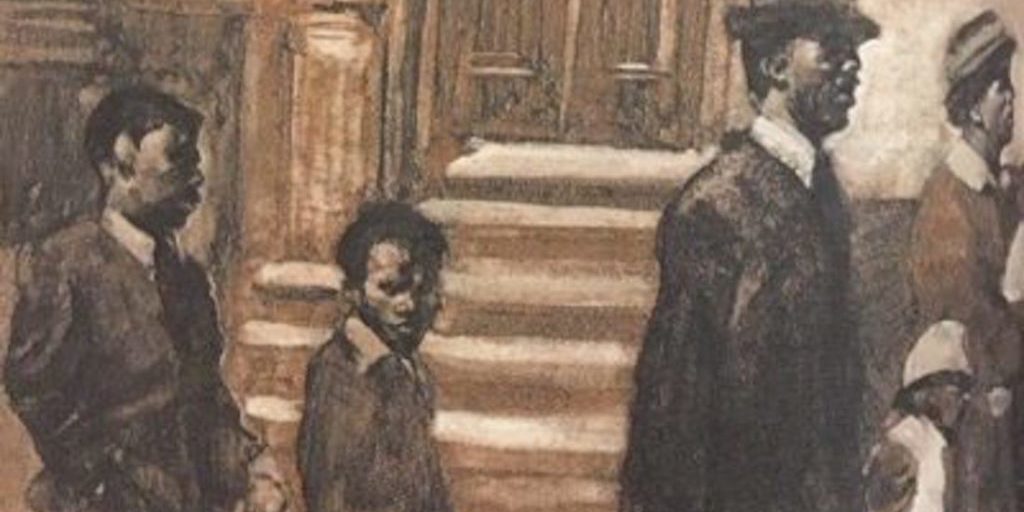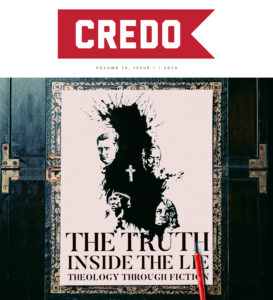
On Not Getting (Over) Getting Saved: James Baldwin and Go Tell It On the Mountain
 The new issue of Credo Magazine, “The Truth Inside the Lie,” focuses on the relationship between theology and fiction. The following is an excerpt from Tiffany Kriner’s article, “On Not Getting (Over) Getting Saved.” Tiffany Eberle Kriner is an Associate Professor of English at Wheaton College. She received her PhD in English Literature from the University of Wisconsin-Madison in 2005, focusing on 2oth century American literature. She is the author of The Future of the World: An Eschatology of Reading (Fortress Press, 2014). In her research she focuses on the intersection of theology, place, and race within literature.
The new issue of Credo Magazine, “The Truth Inside the Lie,” focuses on the relationship between theology and fiction. The following is an excerpt from Tiffany Kriner’s article, “On Not Getting (Over) Getting Saved.” Tiffany Eberle Kriner is an Associate Professor of English at Wheaton College. She received her PhD in English Literature from the University of Wisconsin-Madison in 2005, focusing on 2oth century American literature. She is the author of The Future of the World: An Eschatology of Reading (Fortress Press, 2014). In her research she focuses on the intersection of theology, place, and race within literature.
When I was a child, God’s salvation truth felt tidy: “If you confess with your mouth that Jesus is Lord and believe in your heart that God saved him from the dead, you will be saved” (Rom. 10:9). That’s Scripture. Even a five-year old could get that. She could tuck it, tiny as a tract or a gumball, in her pocket.
My need for salvation was clear, too. Even putting to one side the daily guilt for whatever I did, which was being written up in God’s book, I had dreams. There were the many-colored flames of hell’s darkness, with bodies swimming through flame waves; what I think must have been the Beast—an anteater, chasing me, snorting me up the chute of his terrible snout.
So naturally, I decided to get it, salvation. One night, I slipped away from my family, who were finishing up supper at the yellowy pine kitchen table. The living room offered only winter deep dark. I knelt down and prayed to accept Jesus into my heart. The weave of the cushions was rough against my elbows as I leaned on my own hands.
I came out of that dark living room into the light of the linoleum kitchen. “I did it,” I said. And that was getting saved.
Looking back, this astounds me. It’s so bare a memory, fashioned in simple sketches for each instant. I thumb them like a flip book to make them come alive again, look closer. I’m not sure I get it anymore. What even happened there, in the dark? And what exactly did I do when “I did it”? I am still thinking about that salvation. I have not gotten it yet.
On His Way
James Baldwin’s Go Tell It on the Mountain tells the story of a Harlem boy, John Grimes, as he gets saved during a Pentecostal Holiness prayer meeting.
The outlines of the story are as simple as the classical unities could require: it all happens in one day, a March Saturday in 1935, John’s 14th birthday. That morning, John wakes to the mystery of himself in between, not yet. He is plagued by spiritual, sexual, and vocational tension. Looking in the mirror during his dusty morning chores, though he can discern the details of his face’s features, he can’t figure out what holds him together: “the principle of their unity was undiscoverable, and he could not tell what he most passionately desired to know: whether his face was ugly or not.”
Everyone says he’s going to be a preacher, “like his father.” He’s the supposed good boy in the family, but he knows he’s sinful—he hates his father and has untoward sexual desires. That birthday, he surveys the path, which forks sharply: one way leads to the holiness of the saint in the church and the other to the evil of the world with its pleasures of sin for a season—and death at the end. His future in the church, then, seems hardly able to be resisted: “not until the morning of his fourteenth birthday did he really begin to think about it, and by then it was already too late.” Thus the novel seems to give away the ending on page one: it’s all a foregone conclusion.
The plot follows along in simple enough steps. John burns his birthday money at the forbidden movies, feeling even there in the dark that he’s been found out—for the film blazes that the wages of sin is death. And just in case the screen veils things too much, John’s brother gets stabbed while he’s out, just reinforcing what awaits the recalcitrant sinner.
When he goes to fulfill his janitorial duty at church and stays for Saturday tarry service, John finds himself lying “astonished beneath the power of the Lord.” In a dark vision, he descends into a loveless underworld and calls on the mercy of the Lord, who appears for a moment and brings him through. He comes to himself by church time Sunday morning, “saved,” and “coming” and “on [his] way.”
Prayers of the Saints
Of course, it’s not that simple, even if it is tidy in outline. The thick middle of the story, “The Prayers of the Saints” tells the spiritual backstory to the storefront church. It reveals to the reader everything that John doesn’t know about John’s aunt Florence, his step-father Gabriel, and his mother Elizabeth. That is, it uncovers what the silences and disconnection in his family hide, the unacknowledged racialized history behind John’s desire for the glory and power of the sinful world.
“The Prayers of the Saints” shows us not just what is going to drive John to the church, but also how history and the individual life come together in all of the characters, driving them toward the high tower of the church. Craig Werner calls that thick middle of the novel a “Faulknerian excavation of history,” which is fair enough, for it is likely, if John never learns it—and possibly even if he does—to bury him in its dirt. No wonder he’s called John Grimes.
“The Prayers of the Saints” is also as fair an exploration as you might find of how sin spreads beyond the individual’s soul-in-need-of-saving—permeates towns, regions, cultures, worlds. The novel makes it clear that the malignancy of slavery has mutated and spread during Reconstruction through the lymph of the body politic.
A violent gang rape of Deborah, Florence’s childhood friend, by white men in the southern town where Florence, Deborah, and Gabriel grew up, illustrates the shame of victimization that warps the entire community: “No man would approach her in honor because she was a living reproach, to herself and to all black women and to all black men.” Racism crushes individual bodies and whole communities both. The constant threat of lynching and ongoing economic inequality that the novel describes not only twists Gabriel, an individual sinner, but breaks families and participates in a wicked racist sexism that reaches culture wide, and drives black people, women and men both, as refugees to a north different only in that it “promised more.”
Gabriel, John’s stepfather, comes to see the church as a possible way to get out of the sinkhole of his social and economic position:
For he desired in his soul, with fear and trembling, all the glories that his mother prayed that he should find. Yes, he wanted power–he wanted to know himself to be the Lord’s anointed, His well-beloved, and worthy, nearly, of that snow-white dove which had been sent down from Heaven…
Yet this longing for (“snow-white”?) love and meaning—unmet in the context of white social control in the south—has bent him into a mimic of what he wanted to escape: “He wanted to be master, to speak with that authority which could only come from God.” He’s a preacher abusing others, and he has a bloody secret on his hands.
John gets none of this, of course. And mixed up with that back story, John’s vision and John’s salvation become all the murkier. Who’s to say that John won’t end up “like his father” in more ways than one, a preacher of God’s saving love with a heart full of the most sickening hate? He already hates his father, without being able to articulate why. Even if he is saved and on his way.
Saved
The year I got saved was the same year I was diagnosed with a rare, serious kind of cancer, embryonal rhabdomyosarcoma—stage 3, a chicken-egg-sized tumor of abnormally embryonic cells in my neck. It started with inexplicable pain—and no one knew why for a disturbingly (in retrospect) long while. One doctor told my mother I was over dramatic and crazy. (Not untrue, but a bit beside the point.) It became clear that someone needed to check it out, if only to shut me up. The surgeon, Dr. Brown came out of the OR crying.
Seeing his face, everyone panicked a little. My grandmother wailed, “She’s going to die!” There was a brief pause, and then one of my aunts did that teeth sucking thing. And then she said, “Ma. She’s not going to die.”
(I knew nothing of it at the time, being under anesthesia, wrapped in a pressure bandage tied so tight that my head would be permanently dented—a hairless line just where bangs were supposed to, in the 1980s, anyway, curl under.)
The girl in the next bed at Roswell Park Cancer Institute had the same disease, same stage. And she did die. She had been a violinist, just 11, the daughter of great string musicians whose loveliness and familial tenderness we’d admired greatly. We never heard any of them play. Her name was Rebecca Heatherington.
Frankly, I wasn’t so sure that I wasn’t on my grandmother’s side of the life-or-death question. I remember one bad time, when my mother said, “If the cancer comes back, do you want to do all this again?” (All this being face-wrecking surgery, maximum radiation that would leave me susceptible to severe sunburns for life, chemotherapy with horrible side effects, including pretty much constant vomiting during drug weeks, for two years, one drug of which leaked into my muscles and eroded parts of my arm musculature forever, that sort of thing). “Or do you want to go and be with Jesus?” I said, “I think I want to go be with Jesus.”
It didn’t really turn out to be up to me, of course. But what surprises me about that memory is the confidence of that moment with my mother. At least Paul hems and haws “I do not know which I prefer” between life and death. Sure, you might say, that’s just five-year-olds and Pelagians everywhere, lords of all they survey, wielding, they suppose, eternal life and death in their tiny fists thanks to an overweening version of free will that seems as much middle class and American as it does heretical.
But I was a miracle—what else was I supposed to think? Cancer had tried to get me, but Jesus saved me. My dad got up and spoke at a tent meeting about my healing. And there were tongues and gospel music belting out of Mrs. Wright, who had recorded a real gospel record. He told them all about the Lord’s healing power, and I was the sign. We marked the anniversaries of survival. One woman my grandmother knew sent me a Madame Alexander doll every December for more than a decade for just the anniversary—each one as finely made as a human child, finer, even—for their own faces and hair were never as bent and cut away as my own. But it was all right if my face was ugly, because everything I did seemed to signify deliverance.
Cancer makes you kind of special like that, if you live with Jesus. Adults would say, “You were saved for a reason.” Strangers would remark upon my red hair (maybe not knowing I’d been hairless as an egg for years) and I somehow learned to respond, “Jesus gave it to me” and explain as a way of sharing the gospel. As if I were chosen for the disease—and chosen to live through it. I got very good grades. I made plans to become an oncologist, a cardiologist, a missionary–all fields that, it occurs to me, aim to save people.
*Read Dr. Kriner’s entire article in the latest issue of Credo Magazine.

